índice
Introdução
The Desert Rose (Adenium obesum) is not just a plant, but a true masterpiece of nature. With its lush flowers and fascinating shapes, cultivating this species becomes a journey full of enchantment and gratification. In this section, we’ll explore the unique beauty of the Desert Rose and unleash the excitement that comes with growing this extraordinary plant. Get ready to dive into a universe of vibrant colors, intriguing shapes and the joy that each petal brings to your green space.
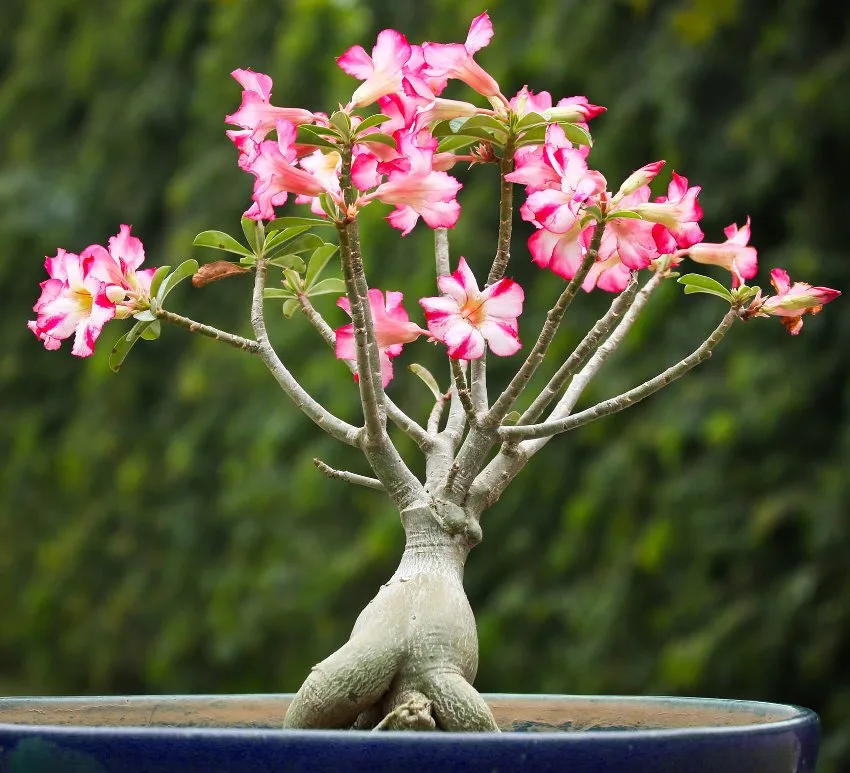
Choosing the Right Desert Rose
When embarking on the journey of growing Desert Rose (Adenium obesum), the choice of variety is crucial. Let’s explore the nuances of this process to ensure you select the perfect rose for your garden.
Identifying Available Varieties:
- Varieties of Double and Single Petals:
- Exploring the differences between flowers with double and single petals.
- Dazzling Colors:
- Highlights include varieties with colors ranging from traditional shades to more exotic hues.
- Unique shapes and sizes:
- Knowledge of varieties with different heights and shapes, allowing a personalized choice.
Considerations on Colors, Sizes and Specific Characteristics:
- Colors and Their Meaning:
- Exploring the symbolism behind specific colors.
- Size and Space Available:
- Tips for choosing sizes that suit your growing space.
- Specific Plant Characteristics:
- Guidance on particular characteristics, such as resistance to specific conditions or adaptability.
By understanding the varieties available and carefully considering specific colors, sizes and characteristics, you’ll be well on your way to growing a Desert Rose that not only blooms, but also enchants with its uniqueness.
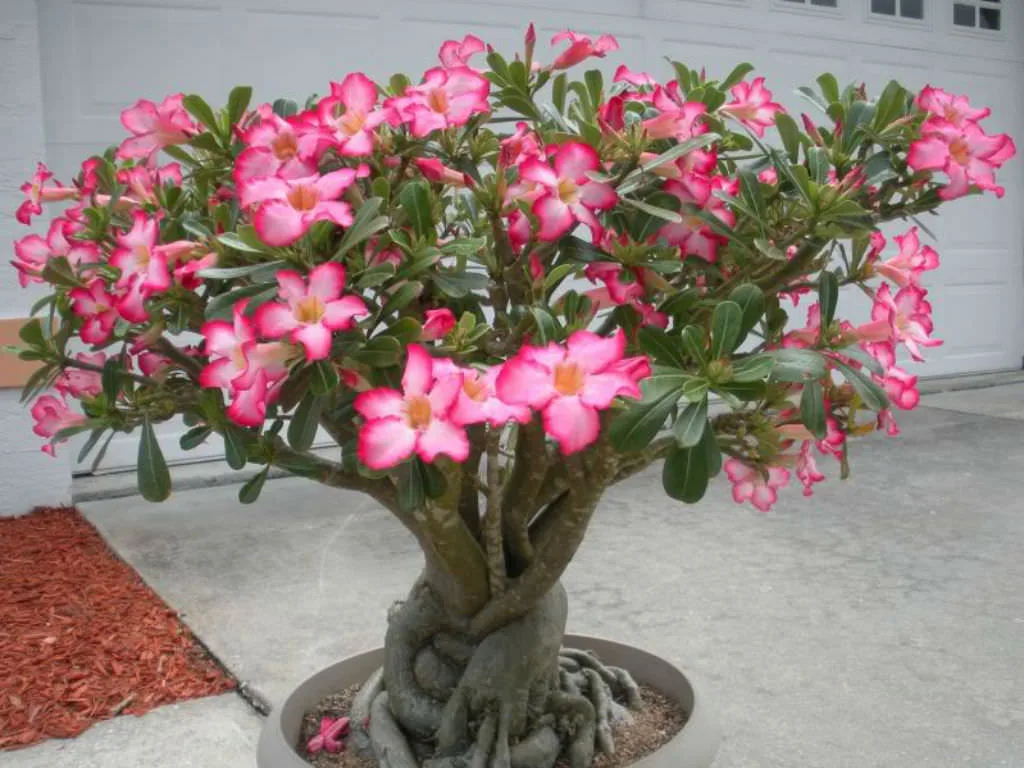
Preparing the Right Soil
Before welcoming the Desert Rose (Adenium obesum) into your garden, it is essential to create a soil conducive to its exuberant flowering. Let’s explore the fundamental guidelines for preparing soil that meets the specific needs of this extraordinary plant.
Ideal Soil Type:
- Sand and Substrate for Cacti:
- The Desert Rose thrives in well-drained, aerated soil.
- Use a specific substrate for cacti, ensuring the right composition.
Importance of Drainage and Aeration:
- Avoiding Water Accumulation:
- Efficient drainage prevents water from accumulating in the roots, preventing rotting problems.
- Promoting Soil Aeration:
- Good aeration facilitates the absorption of nutrients, contributing to the healthy development of the plant.
By following these guidelines, you will provide your Desert Rose with the ideal environment for it to develop strong roots and reach its full potential of beauty and vitality. Careful soil preparation is the first step towards successful cultivation and stunning flowers.
Choosing the Ideal Location
When selecting the location for your Desert Rose (Adenium obesum), sun exposure plays a crucial role in its lush flowering. Let’s explore important considerations and tips to ensure the chosen location is perfect, whether in a garden or in pots.
Considerations on Sun Exposure:
- Full Sun:
- The Desert Rose thrives in direct sunlight.
- Consider areas that receive at least 6 hours of full sun daily.
Tips for Choosing the Perfect Venue:
- Protection Against Extreme Cold:
- Avoid areas subject to frost or extreme cold, protecting the plant during colder seasons.
- Movable Pots for Ideal Fit:
- In pots, choose containers that can be moved to optimize sun exposure throughout the year.
By following these considerations, you ensure that your Desert Rose receives the right amount of sunlight, creating the ideal conditions for healthy growth and a vibrant profusion of flowers. Choosing the perfect spot is like giving your plant a sunny hug, providing it with the ideal environment to thrive.
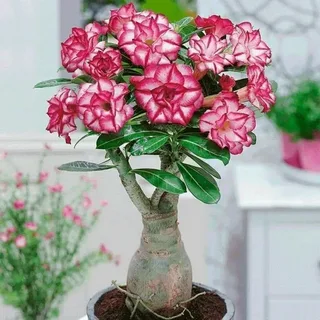
Planting Step by Step
Planting time is crucial for the future flowering of the Desert Rose (Adenium obesum). Let’s explore the essential steps, from careful soil preparation to detailed instructions for planting this botanical gem.
Soil Preparation:
- Choice of Location:
- Identify the planting area, taking into account sun exposure and protection from extreme cold.
- Debris removal:
- Clean the area by removing debris, stones or roots that could interfere with root growth.
- Soil Preparation:
- Mix the cactus substrate with sand, ensuring good aeration and drainage.
Doing the Planting:
- Choice of Vessel (if applicable):
- If planting in pots, choose containers with drainage holes.
- Desert Rose placement:
- Position the plant centrally in the soil, avoiding burying it too deep.
- Filling and Compacting:
- Fill in the substrate around the roots, compacting it lightly.
- Starting Rule:
- After planting, water gently to help firm the soil.
By following these steps carefully, you will be laying the foundations for a healthy and vibrant Desert Rose. Planting is the first chapter of a journey that will culminate in a stunning floral spectacle.
Rega and Initial Care
Proper watering is vital for the successful cultivation of the Desert Rose (Adenium obesum). In this section, we’ll cover the frequency and amount of water needed, as well as special care in the first few days after planting, ensuring a solid foundation for future flowering.
Frequency and Quantity of Water Required:
- Moderate Rega:
- The Desert Rose prefers slightly dry soil between waterings.
- Avoid overwatering to prevent root rot problems.
- Observation of the Sheets:
- Monitor the leaves; if they start to wilt, it’s a sign that the plant needs water.
Special Care in the First Days after Planting:
- Starting Rule:
- After planting, carry out an initial watering to establish the roots.
- Protection Against Extreme Conditions:
- Avoid watering excessively in the first few days and protect the plant from extreme weather conditions.
By understanding the specific watering needs of the Desert Rose and providing special care in the early days, you will be cultivating an environment conducive to healthy flowering. Watering, when done judiciously, is the key to nurturing the splendor of this unique plant.
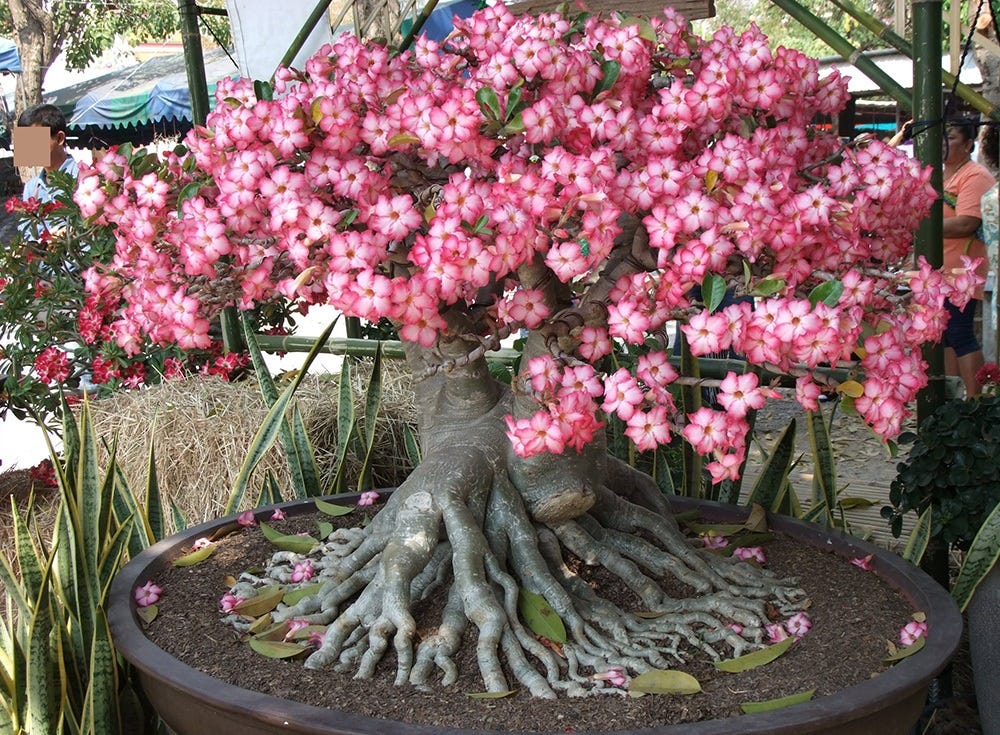
Fertilizing for Healthy Growth
Ensuring that the Desert Rose (Adenium obesum) receives the right nutrients is essential for lush growth. In this section, we will explore guidelines on essential nutrients, as well as recommendations for types of fertilizer and the ideal frequency of application.
Guidelines on Essential Nutrients:
- NPK Balanced:
- Choose a balanced fertilizer with the right proportions of Nitrogen (N), Phosphorus (P) and Potassium (K).
- Microelements:
- Make sure the fertilizer contains micronutrients such as iron, zinc and magnesium.
Recommendations for Types of Fertilizer and Frequency of Application:
- Slow Release Granular Fertilizer:
- Use slow-release fertilizers for gradual nutrition.
- Application in spring and summer:
- Fertilize regularly during spring and summer, when growth is most active.
- Reduction in Inactive Season:
- Reduce the frequency during the fall and winter, respecting the dormant period.
By following these guidelines, you’ll be providing your Desert Rose with the nutrients it needs for healthy growth and a profusion of magnificent flowers. Fertilizing is the key to maintaining the vitality and lasting beauty of this enchanting plant.
Poda and Modeling
Pruning is a fundamental practice for promoting vigorous growth and exuberant flowering of the Desert Rose (Adenium obesum). In this section, we’ll highlight the importance of this technique and provide step-by-step instructions for proper pruning, allowing you to shape the unique beauty of this plant.
Importance of Pruning: Stimulating Growth and Flowering:
- Stimulus to Branching:
- Regular pruning encourages lateral branches to grow, resulting in a fuller, more lush plant.
- Size control:
- It allows you to control the size of the Desert Rose, adapting it to the space available.
- Stimulating Flowering:
- Pruning removes wilted flowers, encouraging the continuous production of new buds.
Step-by-step instructions for proper pruning:
- Sharp Tools:
- Use sharp pruning shears to avoid damaging the plant’s tissues.
- Removal of Wilted Flowers:
- Gently cut off the wilted flowers, making sure the cut is close to the branch.
- Excessively Long Branches:
- To control size, cut excessively long branches, preferably above a leaf node.
- Drinking or Damaged Branches:
- Remove diseased or damaged branches to promote the overall health of the plant.
By pruning according to these instructions, you will be sculpting the elegance of the Desert Rose, encouraging healthy growth and stunning flowers. Pruning is a valuable tool for enhancing the intrinsic beauty of this unique plant.
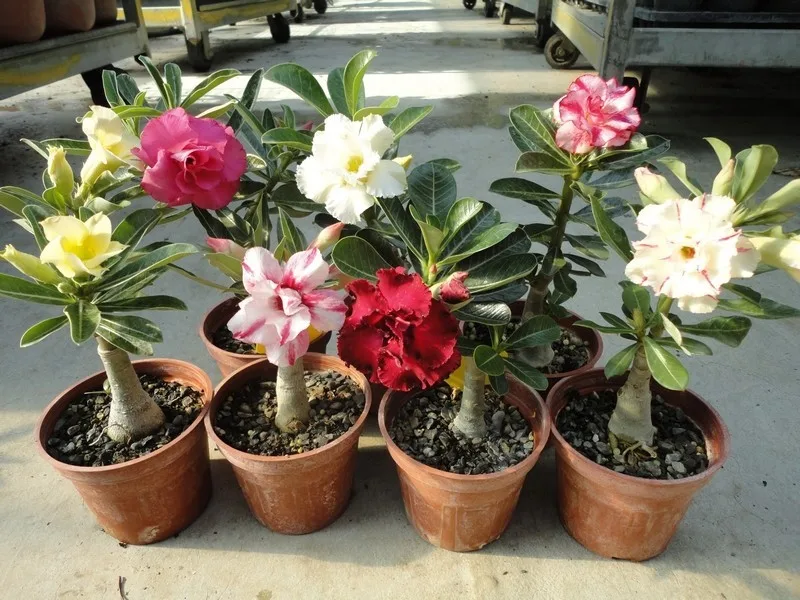
Solving Common Problems
When growing the Desert Rose (Adenium obesum), it’s important to be aware of the challenges that can arise, from pests to diseases. In this section, we’ll look at identifying and dealing with common problems, as well as providing tips for dealing with challenges during cultivation.
Identification and Treatment of Pests and Diseases:
- Mites:
- If you notice small dots or webs, your plant may be infested by spider mites. Use a suitable insecticidal oil.
- Bugs:
- White or cottony spots on the plant may indicate mealybugs. Remove them manually or use an insecticidal soap.
- Root Rot:
- Softening at the base of the plant may indicate root rot. Reduce watering and replant in dry soil.
Tips for Dealing with Possible Challenges:
- Regular Monitoring:
- Inspect the plant regularly to detect signs of problems before they worsen.
- Avoid Excess Water:
- Maintain a balance in watering to avoid problems related to excess humidity.
- Quarantine of New Plants:
- Isolate new plants for a few weeks before integrating them into your space to prevent the spread of pests.
By addressing potential problems promptly and adopting preventative practices, you will contribute to the robust health and resilience of your Desert Rose, ensuring long-lasting beauty. Vigilance is the key to successful cultivation and fully enjoying the magnificence of this unique plant.
Picking Dazzling Flowers:
The culmination of growing the Desert Rose (Adenium obesum) is the dazzling sight of its flowers. In this section, we’ll explore indicators that the plant is ready to bloom and how to make the most of the beautiful flowers it offers.
Indicators that the Desert Rose is Ready to Bloom:
- Healthy Crotches:
- The presence of healthy shoots is a clear sign that the plant is preparing for flowering.
- Increase in Growth:
- More robust growth and the formation of new branches are positive indicators.
- Floral bud swelling:
- Swollen flower buds are the imminent promise of a floral display.
How to Make the Most of Beautiful Flowers:
- Take Good Care During Flowering:
- Keep watering moderate and provide balanced fertilization during the flowering period.
- Appropriate Removal of Wilted Flowers:
- Gently remove wilted flowers to encourage continued production.
- Highlighted Display:
- Place the plant in a spot where everyone can appreciate its beauty when it is in full bloom.
By following these guidelines, you’ll be prepared to harvest not just flowers, but a spectacle of beauty that rewards your dedicated care of the Desert Rose. Flowering is a magical moment that celebrates the success of your cultivation and the extraordinary nature of this unique plant.
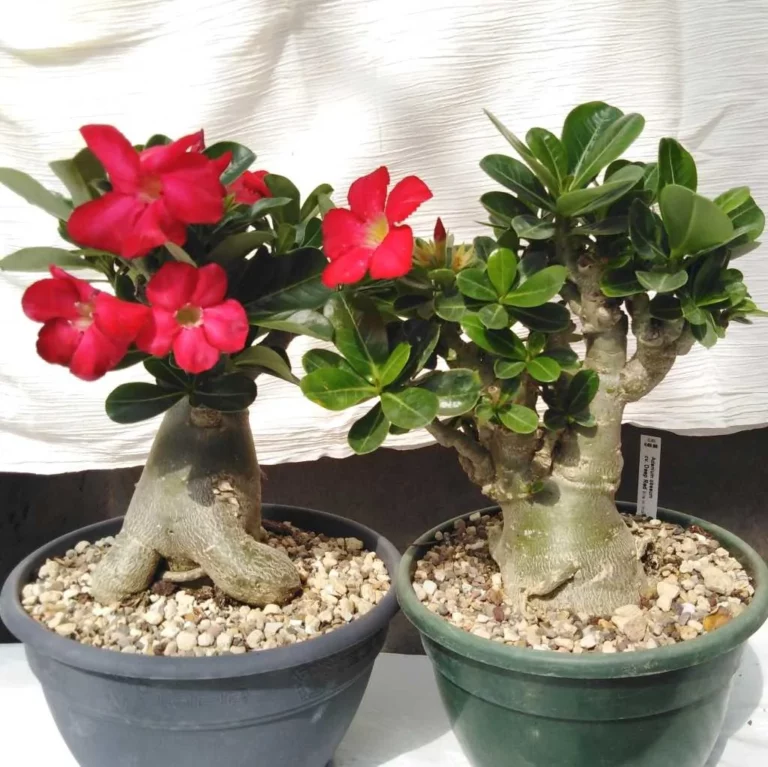
Conclusion
As we come to the end of this guide, it’s essential to recap the crucial steps for planting and caring for the Desert Rose (Adenium obesum). Each stage, from choosing the plant to harvesting the stunning flowers, is a unique and rewarding journey.
Recap of the Crucial Steps:
- Choosing the Right Plant:
- Identify the varieties and characteristics that best suit your preferences.
- Suitable Soil:
- Prepare well-drained soil to encourage healthy root growth.
- Solar Exposure:
- Choose a location with adequate sun exposure to promote flowering.
- Conscious Rega:
- Maintain balanced watering, avoiding excesses that could damage the roots.
- Balanced Fertilization:
- Provide essential nutrients through balanced fertilizers adjusted to seasonal needs.
- Strategic Platform:
- Use pruning to stimulate growth, control size and promote lush flowering.
Encouraging the Continuous Practice of Good Gardening Techniques:
By growing the Desert Rose, you not only create a stunning garden, but also engage in an enriching experience. We encourage the continuous practice of good gardening techniques, close observation and dedicated care. With each new sprout, rejoice in the ability to nurture and witness nature’s magnificence in its most enchanting form.
By following these guidelines, you’re well on your way to enjoying a stunning garden where the Desert Rose blooms like a radiant jewel. Remember, patience and dedication are rewarded with the lasting beauty of this unique plant. May your gardening journey be filled with vibrant colors and moments of pure wonder!
Frequently Asked Questions
Can you plant a desert rose directly in the ground?
Yes, it is possible to plant the desert rose directly in the ground, but it is crucial to ensure that the soil is well-drained to avoid water accumulating in the roots. Make sure you choose a spot with adequate sun exposure to promote the plant’s flowering.
What kind of soil should you plant a desert rose in?
The desert rose thrives in sandy, well-drained soil. A specific mix for cacti and succulents, which provides good aeration and drainage, is recommended. Adding perlite or coarse sand to the soil can further improve drainage conditions.
How do you plant a desert rose?
To plant the desert rose, start by choosing a pot or planting site with drainage holes. Prepare suitable soil by making a mixture of soil for cacti and succulents. Plant the desert rose at a depth that allows the roots to be covered, and water moderately. Keep the plant in direct sunlight and adjust care as necessary to promote healthy growth.







